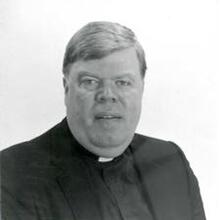Last month a blue wall sprang up in Berlin.
Seventy-nine feet long, the soaring wall of glass is a monument to the 300,000 victims of the Third Reich’s euthanasia program. From January 1940 to August 1941, German medical personnel killed 70,000 people in gas chambers. Those with serious mental and physical disabilities were soon joined by people simply judged to be social misfits. Protests by the Catholic Church, led by Clemens von Galen, bishop of Münster, forced the German government to announce the end of the program in 1941. But it continued in secret. More than 200,000 new victims were executed through lethal injection or starvation.
Popularly known as T-4, the National Socialists’ euthanasia campaign was housed at Tiergartenstrasse 4 in Berlin. In the mansion located at this address, scores of doctors and bureaucrats planned the program’s victim rolls, construction of “hospitality centers” and methods of execution. The euthanasia memorial stands on land immediately in front of the old Tiergartenstrasse headquarters. The building itself has an odd history. The German government confiscated the mansion from its Jewish owners and then “Aryanized” it by putting it to eugenic use. A sleek palace housing the Berlin Philharmonic now stands on the site. The strains of Mozart have covered over the T-4 staff’s deliberative whispers, which had replaced the Hanukkah songs of the earlier Jewish family.
Unsurprisingly, the abstract monument has attracted criticism from victims’ relatives and the general public. Why are there no human figures or even names on the wall itself? In fact, the designers Ursula Wilms, Heinz Hollman and Nicholaus Koliusis have created a window eloquent by its very anonymity.
The blue tint is not arbitrary. It reproduces the color of the questionnaire used by euthanasia supervisors to determine who would die. As a nearby information panel informs us, the most important question on the form asked whether the candidate was “productive.” By the end of the war, the most damning description of a potential victim was “work-adverse.”
The transparent wall evokes the anonymity of the T-4 victims themselves. The memorial to the euthanasia victims did not open until years after Berlin had inaugurated monuments to other Third Reich victims: Jews, Roma, homosexuals. In the postwar Nuremberg trials, several architects of the T-4 campaign were executed or imprisoned, but most participants eluded prosecution. Their crimes were quickly forgotten. Virtually no one received compensation from either the West or East German governments for the suffering of a disabled relative. As historians work on the archives of the T-4 program, German grandchildren have suddenly discovered that a previously unknown aunt or uncle had perished in the euthanasia campaign. This long forgetting of these particular victims of Nazism reflects the irrational shame that has long shrouded the treatment of the disabled. Earlier in the 20th century, people with mental illness and serious physical handicaps were to be hidden away, preferably in rural institutions with few visitors. This social sequestration facilitated the occult killing of the disabled. Few questions were raised about the mendacious death notices concerning those whom polite society had already banished as an embarrassment.
As visitors gaze through the blue glass, they perceive people on the other side through one tinted lens. Just as the disabled can be perceived and dismissed on the basis of one flaw, the observed visitor is reduced to one dull color in the monochrome blur. The tinted glass distorts the image of those on the other side. A bandaged limb or a hearing aid or a limp is suddenly magnified.
The blue wall also serves as a mirror for the spectators. A large number of those visiting the monument in its first weeks were seated in wheelchairs, a visual reminder of the progress made in recent decades to integrate the disabled into mainstream society. But the wall’s mirror also functions as an indictment. The eugenic dream was not eliminated by the Allied victors or the Nuremberg tribunals. It still seduces. The infanticide of the disabled and the killing of the chronically ill are no longer just memories from a distant, censured past. The tragedy we commemorate and lament as we gaze at the blue wall on Tiergartenstrasse still threatens to become our own.








